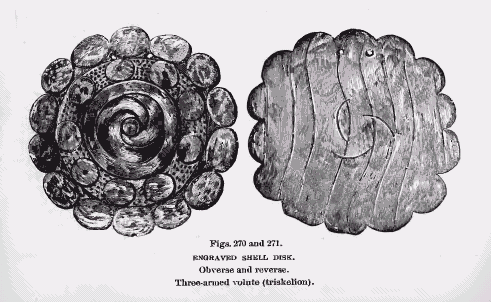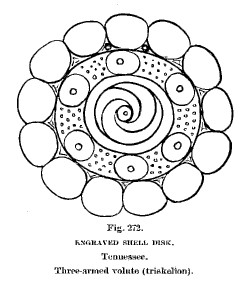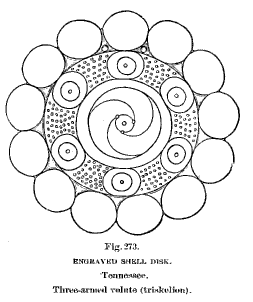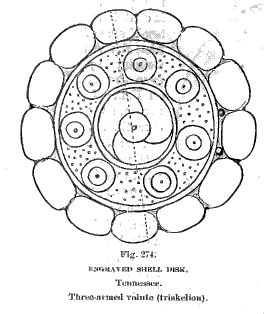

The Swastika
Forms Allied to the Swastika

 a
specimen of the deposit and original condition of these objects:
a
specimen of the deposit and original condition of these objects:In a carefully constructed stone sarcophagus in which the face of the skeleton was looking toward the setting sun, a beautiful shell ornament was found resting upon the breastbone of the skeleton. This shell ornament is 4.4 inches in diameter, and it is ornamented on its concave surface with a small circle in the center and four concentric bands, differently figured, in relief. The first band is filled up by a triple volute; the second is plain, while the third is dotted and has nine small found bosses curved at unequal distances upon it. The outer band is made up of fourteen small elliptical bosses, the outer edges of which give to the object a scalloped rim. This ornament, on its concave figured surface, has been covered with red paint, much
 of
which is still visible. The convex smooth surface is highly polished and
plain, with the exception of the three concentric marks. The material
out of which it is formed was evidently derived from a large flat seashell.
* * * The form of the circles or "suns" carved upon the concave
surface is similar to that of the paintings on the high rocky cliffs on
the banks of the Cumberland and Harpeth rivers. * * * This ornament when
found lay upon the breastbone with the concave surface uppermost, as if
it had been worn in this position suspended around the neck, as the two
holes for the thong or sting were in that portion of the border which
pointed directly to the chin or central portion of the jaw of the skeleton.
The marks of the thong by which it was suspended are manifest upon both
the anterior and posterior surfaces, and, in addition to this, the paint
is worn off from the circular space bounded below by the two holes.
of
which is still visible. The convex smooth surface is highly polished and
plain, with the exception of the three concentric marks. The material
out of which it is formed was evidently derived from a large flat seashell.
* * * The form of the circles or "suns" carved upon the concave
surface is similar to that of the paintings on the high rocky cliffs on
the banks of the Cumberland and Harpeth rivers. * * * This ornament when
found lay upon the breastbone with the concave surface uppermost, as if
it had been worn in this position suspended around the neck, as the two
holes for the thong or sting were in that portion of the border which
pointed directly to the chin or central portion of the jaw of the skeleton.
The marks of the thong by which it was suspended are manifest upon both
the anterior and posterior surfaces, and, in addition to this, the paint
is worn off from the circular space bounded below by the two holes.Fig. 271 represents the back or convex side of the disk shown in fig. 270. The long curved lines indicate the laminations of the shell, and the three crescent-shaped figures near the center are perforations resulting from the deep engraving
 of
the three lines of the volute on the concave side. The stone grave in
which this ornament was found occupied the summit of a mound on the banks
of the Cumberland River, opposite Nashville, Tenn.
of
the three lines of the volute on the concave side. The stone grave in
which this ornament was found occupied the summit of a mound on the banks
of the Cumberland River, opposite Nashville, Tenn.Figs. 272, 273, and 274 are other representations of shell carved in spirals, and may have greater or less relation to the Swastika. (2) They are inserted for comparison and without any expression of opinion. They are drawn in outline, and the spiral form is thus more easily seen.
Mr. Holmes (3) makes some observations upon these designs and gives his theory concerning their use:
I do not assume to interpret these designs; they are not to be interpreted. All I desire is to elevate these works from the category of trinkets to what I believe is their rightful place --- the serious art of a people with great capacity for loftier works. What the gorgets themselves were, or of what particular value to their possessor, aside from simple ornaments, must be, in a measure, a matter of conjecture. They were hardly less than the totems of clans, the insignia of rulers, or the potent charms of the priesthood.
The spider. --- The spider was represented on the shell gorgets. Figs. 275, 276, 277 and 278 (4) present four of these gorgets, of which figs. 275 and 277 display the Greek cross in the center, surrounded by two concentric incised lines forming a circle which is the body of a spider. Fig. 276 shows the same spider and circle, and inside of it a cross much resem-
ENDNOTES:
1. Second Ann. Rep. Bureau of Ethnology, 1880-81, p. 276, pl. 56, figs. 1,2. [Back]
2. Op. cit., p. 276, pl. 56, figs. 3, 5, 6. Back
3. Op. cit., p. 281. Back
4. Second Ann. Rep. Bureau of Ethnology, 1880-81, pl. 61. Back
<< Previous Page Next Page >>
© 2004-2007 Northvegr.
Most of the material on this site is in the public domain. However, many people have worked very hard to bring these texts to you so if you do use the work, we would appreciate it if you could give credit to both the Northvegr site and to the individuals who worked to bring you these texts. A small number of texts are copyrighted and cannot be used without the author's permission. Any text that is copyrighted will have a clear notation of such on the main index page for that text. Inquiries can be sent to info@northvegr.org. Northvegr™ and the Northvegr symbol are trademarks and service marks of the Northvegr Foundation.

|